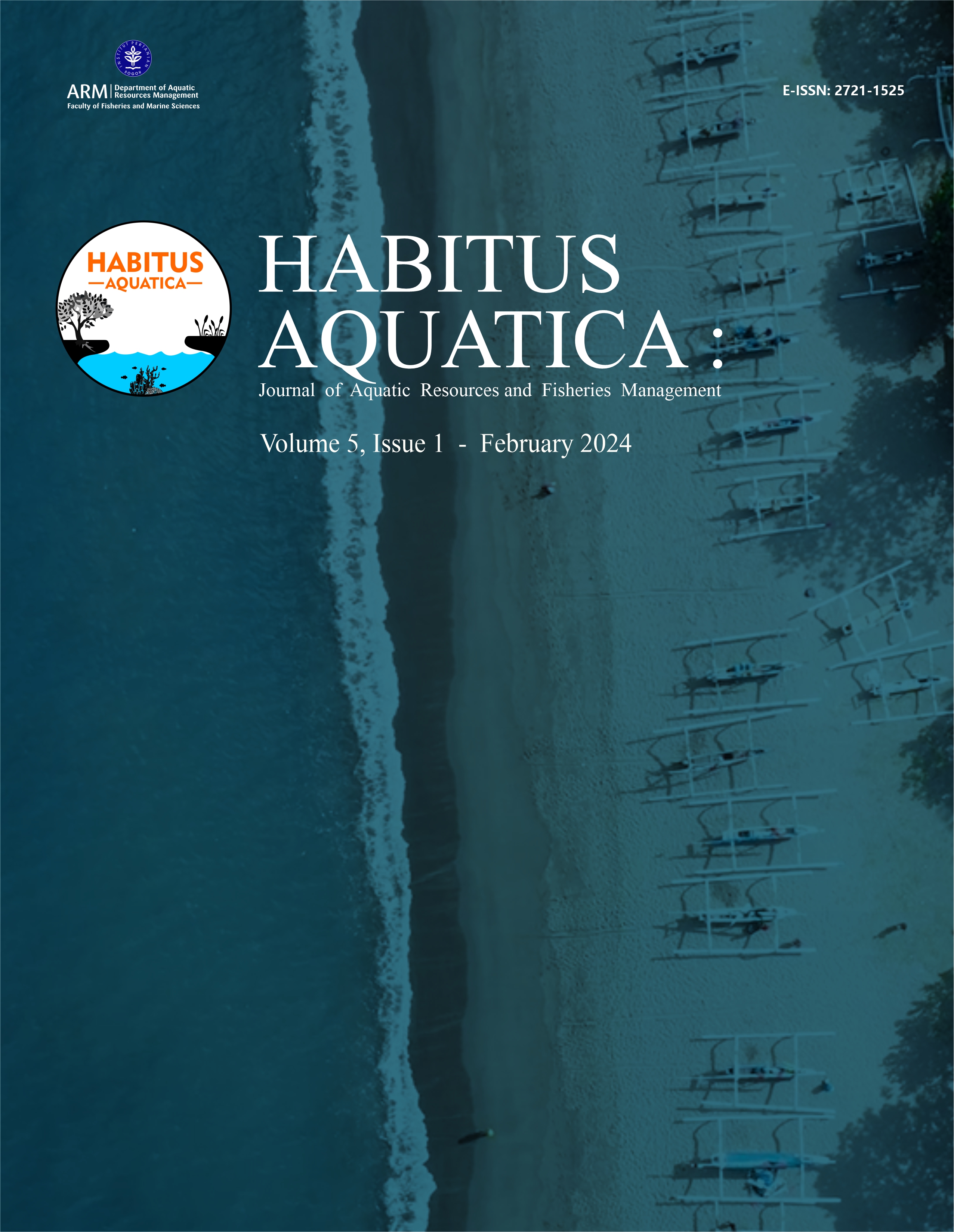Types and abundance of microplastics in red snapper (Lutjanus malabaricus) in Kupang Bay Waters, East Nusa Tenggara Timur
Abstract
Microplastics are plastic particles that have a size of <5 mm. Its small size means it can be transported to all waters and biota, including fish. Sources of microplastic waste in waters include industry, agriculture and anthropogenic activities, all of which can be a source of microplastic pollution in the sea. Red Snapper (Lutjanus malabaricus) is a type of demersal fish that lives in groups at the bottom of coral or coral reefs. Red Snapper is a category of fishery products that has important economic value and is in great demand by the public. This research aims to identify the type, color, abundance and size of microplastics in Red Snapper fish. Sampling was carried out in September-October 2022 with a total of 50 fish samples studied. Identification of microplastics based on the shape, size and color of the microplastic particles. The results of the research found as many as 1,593 microplastic particles in the Red Snapper fish samples consisting of fibers, fragments, films and granules. The highest abundance of microplastics was dominated by the fiber type, namely 17.98 particles/individual in the gills and 11.66 particles/individual in the intestine. The lowest abundance of microplastics overall was in the gills with the film type being 0.28 particles/individual and the granule type being found at 0.3 particles/individual. The colors of microplastics found were white, black, red, yellow, blue, transparent and green. The highest color of microplastics found overall was dominated by white, both in the gills (52.45%) and in the intestines (48.74%), while the lowest was green which was found in the gills (0.42%) and in the intestines. intestine (0.79%). The microplastics found varied in size, namely <0.25 mm - >2 mm. The microplastics found in the two fish organs were mostly 0.50 mm - 2 mm in size. Very few microplastics measuring <0.25 mm were found, both in the intestines and gills.
Downloads
References
Abbasi S, Soltani N, Keshavarzi B, Moore F, Turner A, Hassanaghaei M. 2018. Microplastics in Different Tissues of Fish and Prawn from the Musa Estuary, Persian Gulf. Chemosphere. 205(2):80–87. doi: 10.1016/j.chemosphere.2018.04.076.
Abidli S, Lahbib Y, El Menif NT. 2019. Microplastics in Commercial Molluscs from the Lagoon of Bizerte (Northern Tunisia). Marine Pollution Bulletin. 142(2):243–52. doi: 10.1016/j.marpolbul.2019.03.048.
Avio CG, Gorbi S, Milan M, Benedetti M, Fattorini D, Pauletto M, Bargelloni L, Regoli F. 2015. Pollutants Bioavailability and Toxicological Risk from Microplastics to Marine Mussels. Environmental Pollution Journal. 198(12):211–22. doi: http://dx.doi.org/10.1016/j.envpol.2014.12.021.
Ayuingtyas WC, Yona D, Julinda SH, Iranawati F. 2019. Kelimpahan Mikroplastik Pada Perairan Di Banyuurip, Gresik, Jawa Timur. Journal of Fisheries and Marine Research. 3(1):41–45. doi: 10.21776/ub.jfmr.2019.003.01.5.
Azizah P, Ridlo A, Suryono CA. 2020. Mikroplastik Pada Sedimen Di Pantai Kartini Kabupaten Jepara, Jawa Tengah. Journal of Marine Research. 9(3):326–32. doi: 10.14710/jmr.v9i3.28197.
Boerger CM, Lattin GL, Moore SL, Moore CJ. 2010. Plastic Ingestion by Planktivorous Fishes in the North Pacific Central Gyre. Marine Pollution Bulletin. 60(12):2275–78. doi: 10.1016/j.marpolbul.2010.08.007.
Browne MA, Dissanayake A, Galloway TS, Lowe DM, Thompson RC. 2008. Ingested Microscopic Plastic Translocates to the Circulatory System of the Mussel, Mytilus Edulis (L.). Environmental Science and Technology. 42(13):5026–31. doi: 10.1021/es800249a.
Browne MA, Niven SJ, Galloway TS, Rowland SJ, Thompson RC. 2013. Microplastic Moves Pollutants and Additives to Worms, Reducing Functions Linked to Health and Biodiversity. Current Biology. 23(23):2388–92. doi: 10.1016/j.cub.2013.10.012.
Carson HS, Nerheim MS, Carroll KA, Eriksen M. 2013. The Plastic-Associated Microorganisms of the North Pacific Gyre. Marine Pollution Bulletin. 75(1–2):126–32. doi: 10.1016/j.marpolbul.2013.07.054.
Dewi IS, Budiarsa AA, Ritonga IR. 2015. Distribusi Mikroplastik Pada Sedimen Di Muara Badak, Kabupaten Kutai Kartanegara. Depik. 4(3):121–31. doi: http://dx.doi.org/10.13170/depik.4.3.2888.
Fachrudin A. 2022. Analisis Mikroplastik pada Ikan Kakap Merah (Lutjanus Malabaricus, Bloch & Schneider, 1801) dan Ikan Baronang di TPI Sekitar Teluk Jakarta. Universitas Islam Negeri Syarif Hidayatullah Jakarta.
F Franzellitti S, Canesi L, Auguste M, Wathsala RH, Fabbri E. 2019. Microplastic Exposure and Effects in Aquatic Organisms : A Physiological Perspective. Environmental Toxicology and Pharmacology. 68(11):37–51. doi: 10.1016/j.etap.2019.03.009.
Giri SS, Toruan LNL, Tallo I. 2023. Identifikasi Jenis Sampah Pantai Di Wilayah Pesisir Pasir Putih Kecamatan Sulamu Nusa Tenggara Timur. Polusea: Water And Marine Pollution Journal. 1(2):20–28.
Hamin FI, Toruan LNL, Saraswati SA. 2023. Identifikasi Jenis Sampah Plastik Pada Pantai Wisata Di Pesisir Kota Kupang. Jurnal Bahari Papadak. 4(1):122–128.
Hapitasari DN. 2016. Analisis Kandungan Mikroplastik pada Pasir Dan Ikan Demersal: Kakap dan Kerapu di Pantai Ancol, Palabuhanratu, Dan Labuan. Journal of Chemical Information and Modeling. 1(1):1–27.
Hiwari H, Purba NP, Ihsan YN, Yuliadi LPS, Mulyani PG. 2019. “Kondisi Sampah Mikroplastik Di Permukaan Air Laut Sekitar Kupang Dan Rote, Provinsi Nusa Tenggara Timur.” Pp. 165–71 in Seminar Nasional Masyarakat Biodiversitas Indonesia. Vol. 5.
Jiang C, Yin L, Wen X, Du C, Wu L, Long Y, Liu Y, Ma Y, Yin Q, Zhou Z, Pan H. 2018. Microplastics in Sediment and Surface Water of West Dongting Lake and South Dongting Lake: Abundance, Source and Composition. International Journal of Environmental Research and Public Health 15(10):1–15. doi: 10.3390/ijerph15102164.
Kapo FA, Toruan LNL, Paulus CA. 2020. Jenis Dan Kelimpahan Mikroplastik Pada Kolom Permukaan Air Di Perairan Teluk Kupang. Jurnal Bahari Papadak. 1(1):10–21.
KKP. 2021. Nilai Produksi Dan Angka Konsumi Ikan Kakap Nusa Tenggara Timur. Kupang.
Lusher A, Hollman P, Mendoza-Hill J. 2017. Microplastics in fisheries and aquaculture: status of knowledge on their occurrence and implications for aquatic organisms and food safety. Vol. 615. Roma: Fisheries and Aquaculture Technical Paper.
Lusher AL, Mchugh M, Thompson RC. 2013. Occurrence of Microplastics in the Gastrointestinal Tract of Pelagic and Demersal Fish from the English Channel. Marine Pollution Bulletin .67(2):94–96. doi: 10.1016/j.marpolbul.2012.11.028.
Maharani A, Purba NP, Faizal I. 2018. Occurrence of Beach Debris in Tunda Island, Banten, Indonesia. E3S Web of Conferences. 47(2):1–12. doi: 10.1051/e3sconf/20184704006.
Mboro S, Toruan LNL, Soewarlan LC. 2022. Composition And Amount Of Marine Debris Distributed To Mangrove Ecosystems In Kupang City, East Nusa Tenggara, Indonesia. Biocelebes. 16(2):103–122.
McIlgorm A, Campbell HF, Rule MJ. 2011. The Economic Cost and Control of Marine Debris Damage in the Asia-Pacific Region. Ocean and Coastal Management. 54(9):643–51. doi: 10.1016/j.ocecoaman.2011.05.007.
Mizraji, Ricardo, Camila Ahrendt, Diego Perez-venegas, Juan Vargas, Jose Pulgar, Marcela Aldana, F. Patricio Ojeda, Cristian Duarte, and Cristobal Galbán-malagón. 2017. Is the Feeding Type Related with the Content of Microplastics in Intertidal Fish Gut? Marine Pollution Bulletin. 116(1–2):498–500. doi: 10.1016/j.marpolbul.2017.01.008.
Moore CJ, Moore SL, Leecaster MK, Weisberg SB. 2001. A Comparison of Plastic and Plankton in the North Pacific Central Gyre. Marine Pollution Bulletin. 42(12):1297–1300.
Nerland IL, Halsband C, Allan I, Thomas KV. 2014. Microplastics in Marine Environments: Occurrence, Distribution and Effects. Olso, Norwegia: Norwegian Institute for Water Research.
Ngoc UN, Schnitzer H. 2009. Sustainable Solutions for Solid Waste Management in Southeast Asian Countries. Waste Management 29(6):1982–95. doi: 10.1016/j.wasman.2008.08.031.
NOAA. 2013. Programmatic Environmental Assessment (PEA) for the NOAA Marine Debris Program (MDP). Amerika: Maryland.
Oehlmann J, Schulte-Oehlmann U, Kloas W, Jagnytsch O, Lutz I, Kusk KO, Wollenberger L, Santos EM, Paull GC, VanLook KJW, Tyler CR. 2009. A Critical Analysis of the Biological Impacts of Plasticizers on Wildlife. Biological Sciences. 364(1526):2047–62. doi: 10.1098/rstb.2008.0242.
Panjaitan GGM, Perwira IY, Wijayanti NPP. 2021. Profil Kandungan Dan Kelimpahan Mikroplastik Pada Ikan Kakap Merah (Lutjanus Sp.) Yang Didaratkan Di PPI Kedonganan, Bali. Current Trends in Aquatic Science. 4(2):116–21.
Prabowo NP. 2020. Identifikasi Keberadaan Dan Bentuk Mikroplastik Pada Sedimen Dan Ikan Di Sungai Code, Di Yogyakarta. Universitas Islam Indonesia.
Rochman CM, Tahir A., Williams SL, Baxa DV, Lam R, Miller JT, Teh FC, Werorilangi S, Teh SJ. 2015. Anthropogenic Debris in Seafood: Plastic Debris and Fibers from Textiles in Fish and Bivalves Sold for Human Consumption. Scientific Reports. 5(1):1–10. doi: 10.1038/srep14340.
Sarasita D, Yunanto A, Yona D. 2019. Kandungan Mikroplastik Pada Empat Jenis Ikan Ekonomis Penting Di Perairan Selat Bali. Jurnal Iktiologi Indonesia. 20(1–12).
Toruan LNL, Tallo I, Saraswati SA. 2021. Sebaran Sampah Pantai Di Pulau Timor, Nusa Tenggara Timur: Kajian Pada Pantai Rekreasi. Jurnal Wilayah Dan Lingkungan. 9(1):92–108.
Wahyuningsih W, Prihatiningsih P, Ernawati T. 2013. Parameter Populasi Ikan Kakap Merah (Lutjanus Sp.) Di Perairan Laut Jawa Bagian Timur. Bawal Widya Riset Perikanan Tangkap. 5(3):175–179.
Yudhantari CI, Hendrawan IG, Puspitha NLPR.. 2019. Kandungan Mikroplastik Pada Saluran Pencernaan Ikan Lemuru Protolan (Sardinella Lemuru) Hasil Tangkapan Di Selat Bali. Journal of Marine Research and Technology. 2(2):48–52. doi: 10.24843/jmrt.2019.v02.i02.p10.
Zhao, Jianmin, Ran W, Teng J, Liu Y, Liu H, Yin X, Cao R, Wang Q. 2018. Science of the Total Environment Microplastic Pollution in Sediments from the Bohai Sea and the Yellow Sea, China. Science of the Total Environment. 640–641(1):637–645. doi: 10.1016/j.scitotenv.2018.05.346.
Copyright (c) 2024 Habitus Aquatica

This work is licensed under a Creative Commons Attribution-ShareAlike 4.0 International License.
Authors submitting manuscripts should understand and agree that copyright of manuscripts of the article shall be assigned/transferred to Habitus Aquatica Journal. This work is licensed under a Creative Commons Attribution-ShareAlike 4.0 International License (CC BY-SA). Therefore, Authors and Readers are permitted to share — copy and redistribute the material in any medium or format, and adapt — remix, transform, and build upon the material for any purpose. However, they must give appropriate credit, provide a link to the license, and indicate if changes were made. If you remix, transform or build upon the material, you must distribute your contributions under the same license as the original.



















